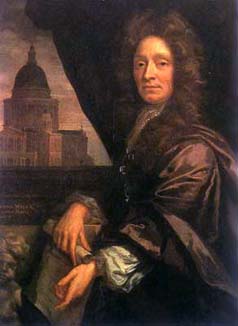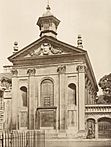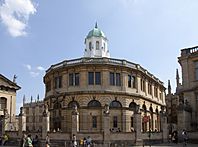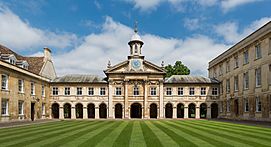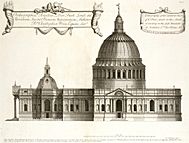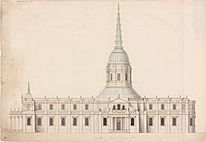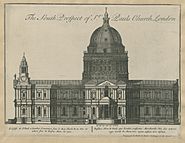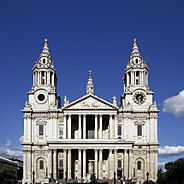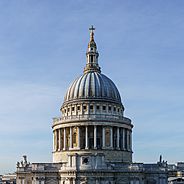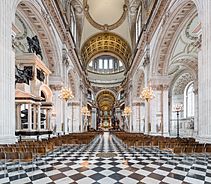Christopher Wren facts for kids
Quick facts for kids
Christopher Wren
|
|
|---|---|
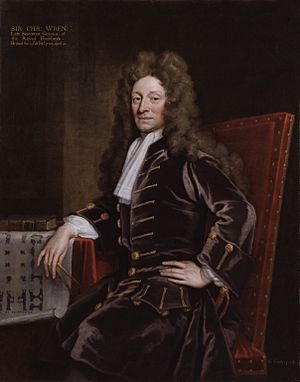
Wren in a portrait by Godfrey Kneller (1711)
|
|
| Born | 30 October 1632 [O.S. 20 October] East Knoyle, Wiltshire, England
|
| Died | 8 March 1723 [O.S. 25 February] (aged 90) St James's, London, England
|
| Nationality | English (later British) |
| Alma mater | Wadham College, Oxford |
| Known for | Designer of 54 London churches, including St Paul's Cathedral, as well as many notable secular buildings in London after the Great Fire |
| Spouse(s) |
Faith Coghill
(m. 1669; died 1675)Jane Fitzwilliam
(m. 1677; died 1680) |
| Children | 4 |
| Parent(s) | Christopher Wren the Elder Mary Cox |
| Scientific career | |
| Fields | Architecture, physics, astronomy and mathematics |
| Institutions | All Souls' College, Oxford |
| Academic advisors | William Oughtred |
| Surveyor of the King's Works | |
| In office 1669–1718 |
|
| Preceded by | John Denham |
| Succeeded by | William Benson |
| 3rd President of the Royal Society | |
| In office 1680–1682 |
|
| Preceded by | Joseph Williamson |
| Succeeded by | John Hoskyns |
| Member of the English Parliament | |
| 1701–1702 | Weymouth and Melcombe Regis |
| 6 March – 17 May 1690 11 January – 14 May 1689 |
New Windsor |
| 1685–1687 | Plympton Erle |
Sir Christopher Wren (born October 30, 1632 – died March 8, 1723) was one of England's most famous architects. He was also a talented scientist, studying anatomy, astronomy, geometry, and physics.
Wren is best known for designing 52 churches in London after the Great Fire of London in 1666. His most famous work is St Paul's Cathedral, which was finished in 1710. Other important buildings he designed include the Royal Hospital Chelsea and the Old Royal Naval College in Greenwich.
He studied at the University of Oxford and was one of the people who helped start the Royal Society, a famous group for scientists. He was even its president from 1680 to 1682. Important scientists like Isaac Newton thought highly of his scientific work.
Contents
Life and Early Studies
Christopher Wren was born in East Knoyle, a village in Wiltshire, England. His father, also named Christopher Wren, was a priest. Christopher was the only son in his family to survive childhood.
As a child, Wren was often sick, but he grew up to live a long and healthy life. He was first taught at home by his father and a private teacher. When he was older, he went to Westminster School for a short time.
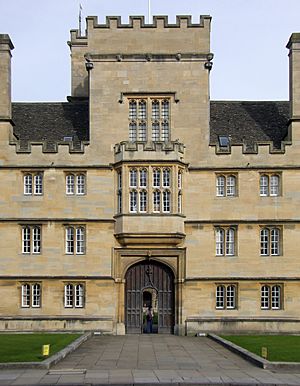
Wren learned Latin and how to draw very well. He was also taught about mathematics by his brother-in-law, Dr. William Holder. Wren used his drawing skills to create many pictures for a book about the brain. He also became very interested in designing and building mechanical tools.
In 1650, Wren went to Wadham College, Oxford. There, he studied Latin and the ideas of Aristotle. He joined a group of thinkers who later helped create the Royal Society. This group greatly influenced his studies in science and math. He earned his first degree in 1651 and a master's degree in 1653.
Scientific Discoveries and the Royal Society
After getting his master's degree, Wren became a fellow at All Souls College, Oxford. He spent this time doing many experiments. For example, he did some of the first experiments involving injecting liquids into the bloodstream of live animals.
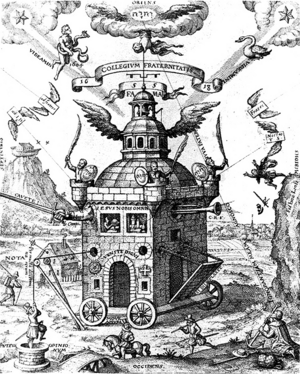
In 1657, Wren became a Professor of Astronomy at Gresham College in London. He gave weekly lectures in both Latin and English. He continued to meet with his friends from Oxford, and these meetings led to the creation of the Royal Society in 1660.
The Royal Society was officially recognized by King Charles II in 1662. Wren was a founding member and later served as its president from 1680 to 1682. His wide knowledge in many subjects helped scientists share their ideas.
From 1661 to 1668, Wren lived in Oxford, but he often traveled to London for Royal Society meetings. In 1661, he became the Professor of Astronomy at Oxford. In 1669, he was made the King's Surveyor of Works, a very important job in charge of royal buildings.
Wren's scientific work covered many areas, including astronomy, optics (the study of light), how to find longitude at sea, and mechanics (the study of motion and forces). He observed, measured, and built models. He also invented and improved many scientific tools.
From Scientist to Architect
Around 1665, Christopher Wren started to focus more on architecture. He traveled to Paris, France, to study the latest building styles. There, he saw the work of Gian Lorenzo Bernini, a famous Italian architect.
When he returned, he began designing a new dome for Old St Paul's Cathedral. However, a week later, the Great Fire of London destroyed most of the city, including two-thirds of the old cathedral. Wren quickly drew up plans to rebuild London, but his ideas were not used.
In 1669, Wren was appointed the King's Surveyor of Works. This meant he was in charge of rebuilding many parts of London. He was personally responsible for rebuilding 51 churches. However, he often worked with other architects on these designs.
Wren was knighted on November 14, 1673, becoming "Sir Christopher Wren." This honor recognized his growing importance as an architect, especially for his work after the Great Fire.
He also served as a Member of Parliament four times. He was elected for Plympton Erle from 1685 to 1687, and for New Windsor in 1689 and 1690 (though these elections were later cancelled). He was elected again for Weymouth and Melcombe Regis in 1701.
Family Life
In 1669, when he was 37, Wren married Faith Coghill. They had two children: Gilbert, who sadly died young, and Christopher, who was born in 1675. The younger Christopher later became an architect like his father and wrote a famous book about the Wren family. Faith Wren died in 1675.
In 1677, Wren married again to Jane Fitzwilliam. They had a daughter named Jane and a son named William. Jane Wren died in 1680. Wren never married again after her death. He lived to be over 90 years old, but was only married for a total of nine years.
Later in his life, some people criticized Wren's work. In 1718, he was removed from his position as Surveyor of the King's Works.
Death and Legacy
Sir Christopher Wren died on February 25, 1723, at the age of 90. He caught a cold that became worse after visiting St Paul's Cathedral.
He was buried in the crypt of St Paul's Cathedral. A memorial to him is there, with an inscription written by his son. The famous inscription, also found on the main floor under the dome, says: "If you seek his monument, look around you." This means that St Paul's Cathedral itself is his greatest memorial.
Architectural Career
Wren' lived during a time when science and building were coming together. Scientists like Galileo Galilei were studying how strong materials were, which was important for building. In London, Wren and his friend Robert Hooke worked together as chief architect and city surveyor after the Great Fire of 1666.
In 1661, King Charles II asked Wren to help with new defenses in Tangier and to repair Old St Paul's Cathedral. Wren chose to focus on the cathedral, which became his most important project.
Early Buildings
Wren's first architectural project was designing a new chapel for Pembroke College, Cambridge. He finished the design in 1662 or 1663, and the chapel was completed in 1665.
His next project was the Sheldonian Theatre in Oxford. Some people didn't love his design for this building, but it was still an important step in his career. Before the theater was finished in 1669, Wren also designed buildings for Trinity College, Oxford and Emmanuel College, Cambridge.
In 1665, Wren traveled to Paris. There, he saw many buildings that followed the ideas of the Italian Renaissance. He also met Gian Lorenzo Bernini, a very famous Italian artist and architect. This trip greatly influenced Wren's future designs.
St Paul's Cathedral
St Paul's Cathedral is the most famous building designed by Wren. He worked on it for 36 years, from the start of construction until it was declared complete in 1711.
Wren first started working on plans for St Paul's in 1661. In 1666, he designed a dome for the old cathedral. But then, the Great Fire of London destroyed the old building. Wren quickly drew up plans to rebuild the entire city.
In 1669, Wren became the King's Surveyor of Works. This gave him a big role in rebuilding London. In 1670, a new law was passed to raise money for rebuilding the churches. Wren presented his first design for St Paul's, which was accepted.
However, this design was later thought to be too simple. So, Wren created a much grander design, known as the "Great Model." This design was approved by the King, and construction began in 1673. But the church leaders wanted a more traditional "cathedral form."
The cathedral that Wren actually built looks different from his earlier plans. The first church service was held in 1697, when Wren was 65. The cathedral was officially declared complete in 1711. Wren was paid the rest of his salary, which had been held back to encourage faster progress. Wren's only small disappointment was that a balustrade (a row of small columns) was added around the roof, which he felt changed his original design.
Other Important Buildings
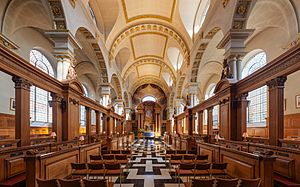
During the 1670s, Wren also designed many important non-church buildings. These included the Monument to the Great Fire of London (1671–76), the Royal Observatory, Greenwich (1675–76), and the Wren Library at Trinity College, Cambridge (1676–84).
After 1680, Wren took on even larger projects. The Royal Hospital Chelsea (1682–92) was one of his first big designs. It was so well designed that it still serves its original purpose today.
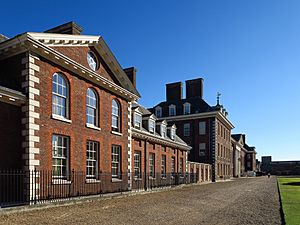
He also worked on the King's House, Winchester (1683–85), but it was never finished. After King Charles II died, Wren focused on projects at Whitehall (1685–87). He designed a new chapel and other rooms for the new king, James II.
Later, Wren worked on Kensington Palace (1689–96) and Hampton Court Palace (1689–1700).
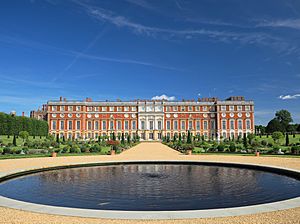
Wren also played a role in the building of the Windsor Guildhall. There's a famous story that the council wanted extra columns inside for support, but Wren believed they weren't needed. He supposedly made the extra columns slightly too short to prove his point. However, it's more likely that his son, also named Christopher Wren, was involved with the building.
Even though he was older, Wren continued to work on important royal projects. In 1696, he became Surveyor of Greenwich Naval Hospital, and in 1698, he was made Surveyor of Westminster Abbey. He held the Westminster Abbey role until he died.
Achievement and Legacy

Sir Christopher Wren was honored in many ways. He appeared on the back of the British £50 banknote from 1981 to 1994.
In 1997, UNESCO recognized Wren's Greenwich Hospital as a World Heritage Site. This means it's considered a very important place for everyone in the world, because of its amazing architecture and art.
See also
 In Spanish: Christopher Wren para niños
In Spanish: Christopher Wren para niños
- List of works by Christopher Wren
- List of Christopher Wren churches in London
- Thomas Gilbert, one of Wren's apprentices and adaptant of his architectural style
- Gresham Professor of Astronomy
- List of presidents of the Royal Society
Wren appears, or is mentioned in several novels or movies set in his time.
- The novel Hawksmoor by Peter Ackroyd, which features a fictionalized Christopher Wren.
- He also features as an important secondary character in Rosalind Laker's (Barbara Ovstedal) novel Circle of Pearls.
- For the character created by Agatha Christie, see the play The Mousetrap.


